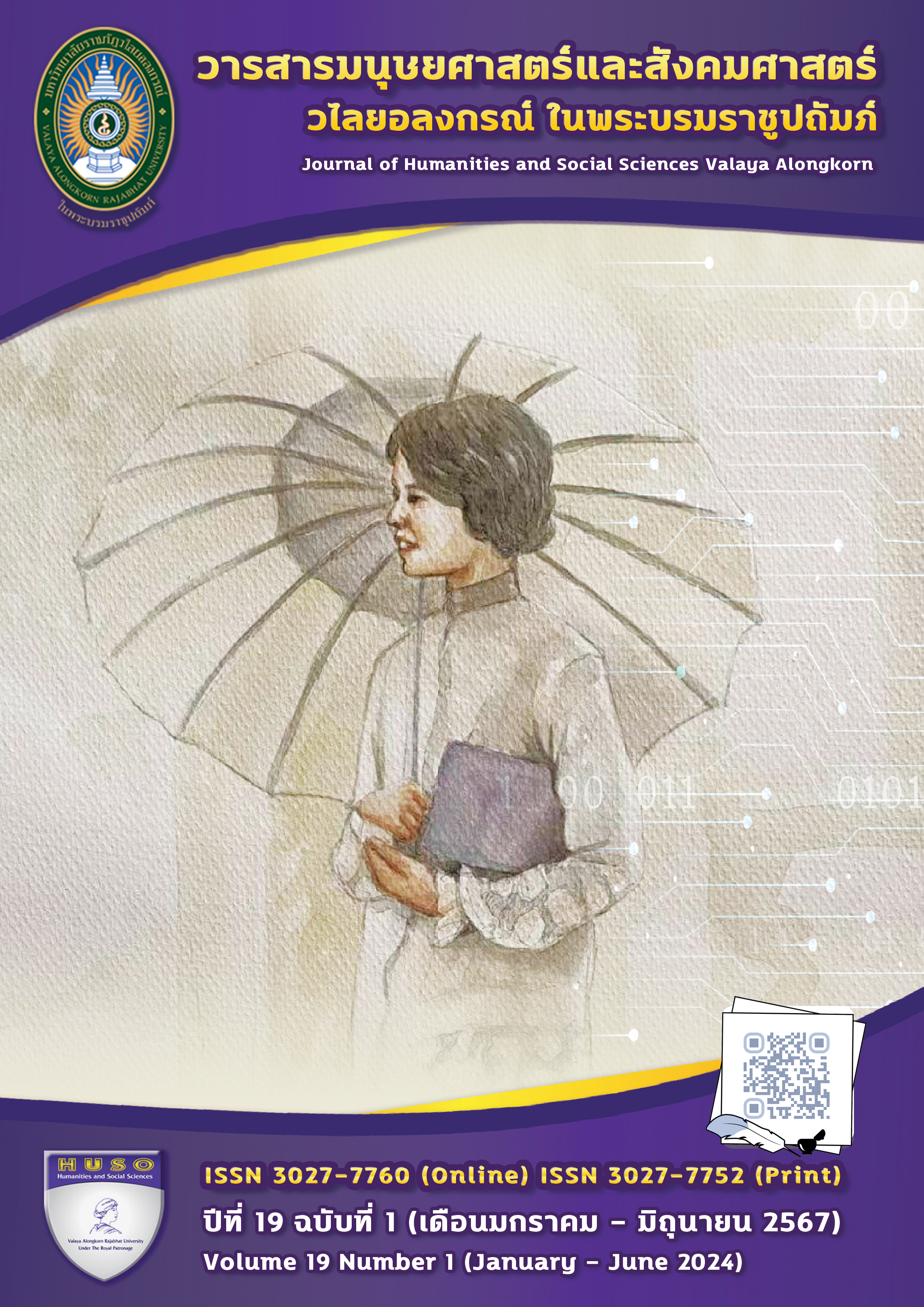A STUDY OF FACTORS INFLUENCING THE EFFICIENCY OF FINANCIAL AND ACCOUNTING PRACTITIONERS IN THE OFFICE OF THE JUDICIARY
Main Article Content
Abstract
The purpose of this academic article is to present knowledge from a literature review on the factors that influence the efficiency of financial and accounting practitioners within the Office of the Judiciary. This study aims to define and elaborate on the variables affecting the efficiency of these practitioners, based on an analysis of 120 related research studies. The review identifies key factors influencing efficiency: work motivation, organizational culture specific to finance and accounting, organizational infrastructure, and work related factors. The findings reveal that work motivation has a direct influence on the efficiency of these practitioners, while organizational culture specific to finance, organizational infrastructure, and work related factors have an indirect influence mediated through their impact on work motivation.
Article Details

This work is licensed under a Creative Commons Attribution-NonCommercial-NoDerivatives 4.0 International License.
ลิขสิทธิ์บทความวิจัยที่ได้รับการตีพิมพ์เผยแพร่ในวารสารมนุษยศาสตร์และสังคมศาสตร์ วไลยอลงกรณ์ ในพระบรมราชูปถัมภ์ ถือเป็นกรรมสิทธิ์ของคณะมนุษยศาสตร์และสังคมศาสตร์ มหาวิทยาลัยราชภัฏวไลยอลงกรณ์ ในพระบรมราชูปถัมภ์ ห้ามนำข้อความทั้งหมดหรือบางส่วนไปพิมพ์ซ้ำ เว้นแต่จะได้รับอนุญาตจากมหาวิทยาลัยเป็นลายลักษณ์อักษร
ความรับผิดชอบ เนื้อหาต้นฉบับที่ปรากฏในวารสารมนุษยศาสตร์และสังคมศาสตร์ วไลยอลงกรณ์ ในพระบรมราชูปถัมภ์ เป็นความรับผิดชอบของผู้นิพนธ์บทความหรือผู้เขียนเอง ทั้งนี้ไม่รวมความผิดพลาดอันเกิดจากเทคนิคการพิมพ์
References
กิตติกานต์ นิลรัตน์. (2563). การศึกษาแรงจูงใจในการปฏิบัติงานของพนักงานบริษัท เอ็นไอ
(ประเทศไทยจำกัด). [สารนิพนธ์ ไม่ได้ตีพิมพ์]. รัฐประศาสนศาสตรมหาบัณฑิต, มหาวิทยาลัยนอร์ท
กรุงเทพ.
จตุพล พัฒนกิจกเจริญการ. (2552). ความคิดเห็นเกี่ยวกับปัจจัยที่มีผลต่อประสิทธิภาพในการปฏิบัติงานของ พนักงานบริษัท อาควา นิซิฮาร่า คอร์ปอเรชั่น จำกัด. [การค้นคว้าอิสระ ไม่ได้ตีพิมพ์].
บริหารธุรกิจมหาบัณฑิต, มหาวิทยาลัยราชภัฏพระนครศรีอยุธยา.
พิมพ์พิศา วรรณวิจิตร และ ปวีณา กองจันทร์. (2560). ปัจจัยหลักที่ส่งผลต่อประสิทธิภาพการจัดทำบัญชี.
คณะบริหารธุรกิจและการบัญชี มหาวิทยาลัยขอนแก่น.
รังสิยา พิทักษ์คีรี. (2563). ความสัมพันธ์ระหว่างสมรรถนะของนักบัญชีที่ส่งผลต่อประสิทธิผลในการปฏิบัติงาน ด้านการบัญชีของกรมการเงินกลาโหม. บัญชีมหาบัณฑิต คณะบัญชี. มหาวิทยาลัยศรีปทุม.
วรรณา อาวรณ์. (2557). แรงจูงใจในการทำงานกับความผูกพันต่อองค์การของข้าราชการรัฐสภา ระดับปฏิบัติงาน สำนักงานเลขาธิการสภาผู้แทนราษฎร. [สารนิพนธ์ ไม่ได้ตีพิมพ์]. รัฐประศาสนศาสตรมหาบัณฑิต,
มหาวิทยาลัยเกริก.
สภาวิชาชีพบัญชี. (2547). พระราชบัญญัติวิชาชีพบัญชี พ.ศ.2547. สืบค้นเมื่อ 9 พฤษภาคม 2567. จาก เว็บไซต์: http://www.tfac.or.th/Article/Detail/66888
สมยศ แย้มเผื่อน. (2551). ปัจจัยที่มีผลต่อประสิทธิภาพการทำงานของพนักงานปฏิบัติการ บริษัท เอเชียนมารีน เซอร์วิสส์ จำกัด (มหาชน). [สารนิพนธ์ ไม่ได้ตีพิมพ์ บริหารธุรกิจมหาบัณฑิต (การจัดการ).
บัณฑิตวิทยาลัย, มหาวิทยาลัยศรีนครินทรวิโรฒ.
Anderson, J.A. (2000). Explanatory Roles of Mission and Culture : Organizational Effectiveness in Tennessees Community Colleges.Dissertation, Ed.D. (Heigher and Audult Education). Menphis : The University of Menphis. Phtocopied.
Baccus, R. E. (1979). The relationship between achievement motivation and organization climate in a selected sample of university deans and department heads. Dissertation Abstracts International, 19(1), 144-146.
Beach, D. S. (1965). Personnel Management People at Work. New York: The Macmillan.
Berry, M. J. A., & Gordon, L. (2002). Data Mining Techniques : For Marketing, Sales and Customer Relationship Management. Indianapolis : Wiley.
Binnie, V. I. (1985). Macpherson LM. A randomized controlled trial of a smoking cessation intervention delivered by dental hygienists: A feasibility study. BMC Oral Health. 7(10), 1-9.
Calori, R. and P. Sarnin. (1991). Corporte Culture and Economic Performance : A French Study. Organization Studies.
Clay, R. (1988). Chambers English Dictionary. Great Britain : bunay Suffolk.
Clements, E. (1983). A study of the relationship between intrinsic and extrinsic variables and job satisfaction among student personal workers in community Colleges. Dissertation Abstracts International, 43(8), 2567.
Daft, R.L. (2013). Understanding the Theory & Design of Organization. 11th editions. Canada: South-Western Cengage Learning.
Deal, Terence E. and Kennedy Allan A. (1982). Corporate Culture: the Rites and Rituals of Corporate Life. Reading, Mass: Addison- Wesley.
Domjan, M. (1996). The Principles of Learning and Behavior Belmont. California: Thomson Wadsworth.
Fink, S. L., Jenk, S. R., & Willit, R.D. (1983). Designing and managing organizations. Illinois: Richard D. Irwin Inc.
Gerloff, E. A. (1985). Organizational theory and design: A strategic approach for management. New York: McGraw-Hill.
Gordon, J.R. (1999). Organizational behavior: A diagnostic approach (6th ed.). Saddle River.
NJ: Prentic Hall International.
Herzberg, F (1959). Federick; Mausner, Bernard; and Synderman, Block the Motivation to Work.
John Willey.
Lovell, R. B. (1980). Adult learning| VOCEDplus, the international tertiary education and research database.
Liau, C. J. (2005). A modal logic framework for multi-agent belief fusion. ACM Transactions on Computational Logic (TOCL), 6(1), 124-174.
Mamun, M. Z. A., & Khan, M. Y. H. (2020). A theoretical study on factors influencing employees performance, rewards and motivation within organisation. Socio Economic Challenges (SEC), 4(3), 113-124.
Mulyana, Y., Chaeroni, N., Erlangga, H., Solahudin, M., Nurjaya, Sunarsi, D., Anggraeni, N., Jamalus, M., I., Yuangga, K. D., & Purwanto, A. (2021). The influence of motivation, ability, organizational culture, work environment on teachers performance. Turkish Journal of Computer and Mathematics Education, 12(4), 99-108.
Maslow, A. (1970). Motivation and personality. New York: Harpers & Row.
Mcgregor, D. (1960). The Human Side of Enterprise. New York : Mcgraw-Hill.
Mendel, P. C. (1988). An investigation of factors that influence teacher moral and
satisfaction with work condition. Dissertation Abstracts International, 48, 25-27.
Mullins, L. J. (1985). Management and organization behavior. London: Pitman.
Ogomaka, U. J. (1986). The factors which motivate California credentials teacher to teach in Los Angeles Archdiocesan high school. Dissertation Abstracts International, 46(12), 41-45.
Patterson, Jerry, Struart Purkey and Jachson Parker. (1988). “Guiding belief of our school district.” In Productive school systems for a national world. Pp.107-109.
Peterson, E. & Plowman, G. E. (1953). Business Organization and Management. (3rd ed.). Ill:Irwin.
Peterson, E., & Plowman, E.G. (1989). Business organization and management. Homewood,
ILL: Richard D. Irwin.
Porter, L.W. and Lawler III, E.E. (1968). Managerial Attitudes and Performance. Homewood, IL; Irwin – Dorsey.
Rizwan, M., Tariq, M., Hassan, R., & Sultan, A. (2014). A comparative analysis of the factors effecting the employee motivation and employee performance in Pakistan. International Journal of Human Resource Studies, 4(3), 35-49.
Ryan, T.A. and Smith, P.C. (1954). Principle of Industrial Psychology. New York: The Mc Donald Press Company.
Valez, G. V. (1972). A Study of Faculty Satisfaction Dissatisfaction with the Intrinsic and Extrinsic Job Factors in Columbia University. Dissertation Abstracts International, 33(3), 997-A.
Vermeeren, B. (2017). Influencing public sector performance: Studying the impact of amoenhancing hr practices on various performance outcomes in the public sector. International Review of Administrative Sciences. doi:10.1177/0020852315591642
Vroom, V. H. (1964). Work and motivation. New York: Wiley.
Robbins, Stephen P & Coulter, Mary. (2002). Management. USA: Prentice Hall.
Wilcox, H. D. (1993). The relationship between the teachers, perception of the high school principle’s leadership style and the correlates job satisfaction and moral. n.p.
Wright, P. M., & Kehoe, R. R. (2007). Human resource services and organizational commitment: A deeper examination. Retrieved from https://bit.ly/33idsdg


